Sony RX100 M1: Lens
Lens Characteristics in Short | A Few Technical Data | Lens Reviews | Some Quotations Regarding the Lens (From Reviews) | References
On this page, I would like to discuss one the specific characteristics that lead us to buy the Sony RX100 M1, namely the lens. I investigate what the available test results and the reviewers say, and I also offer links to camera reviews.
Lens Characteristics in Short
The Sony RX100 M1 features a fixed Carl Zeiss® Vario-Sonnar T* 10.4-37.1mm (28-100 mm equiv.) f/1.8- f/4.9 lens with a zoom range of 3.6 x (7 elements in 6 groups, including AA lens). Thus, it offers the equivalence of five "classic" prime lenses: 28 mm, 35 mm, 50 mm, 70 mm, and 100 mm. Regrettably, it does not have an electronic step zoom, as its successor provides. Zoom is set using the zoom lever or using the control ring around the lens (this is configurable). Manual distance is set using the control ring. There are no marks on the lens, and the camera regrettably lacks distance and depth of field indicators on the LCD screen.
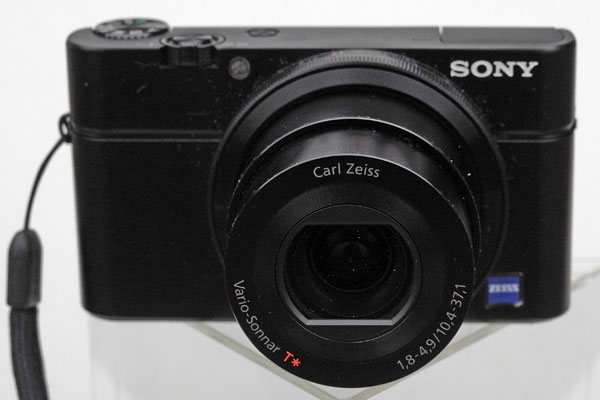 |
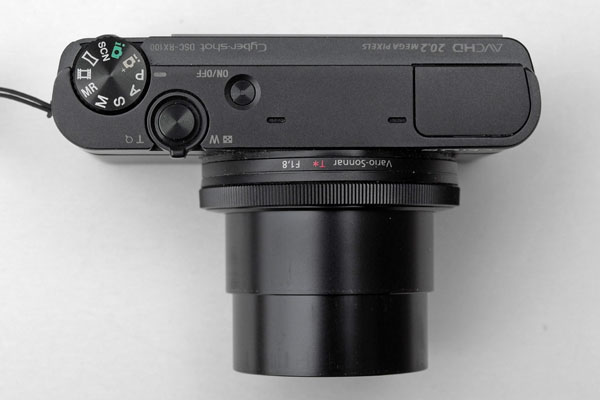 |
Figures: The lens in "on" state from the front (left) and from above (right)
Find more technical information about the lens below.
The lens does not have a filter thread for attaching filters or close-up lenses, but Sony offers an adapter that you can glue to the lens VFA-49R1 49-mm filter adapter). I found, however, another filter adapter from Carry Speed, Carry Speed MagFilter magnetic filter adapter, which seemed more interesting to me, because it fixes filters and lenses to the camera lens using magnetic force. We bought the 52 mm filter thread version, because this fits our close-up lenses.
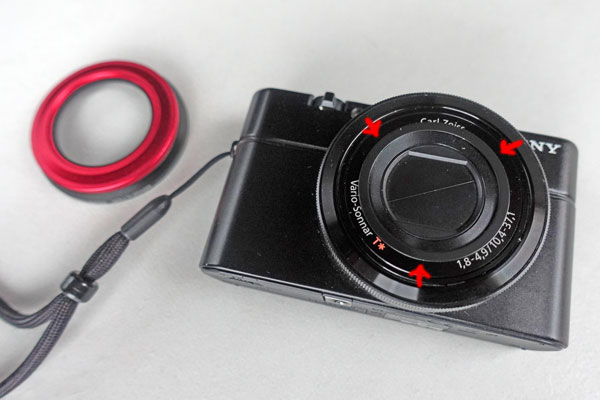 |
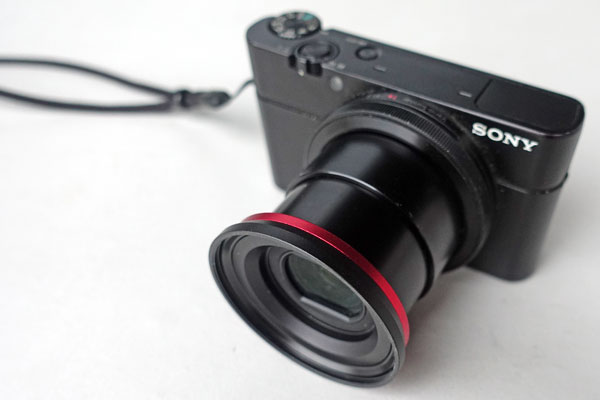 |
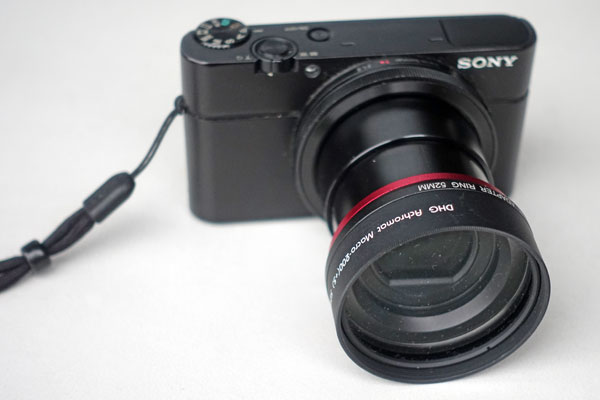 |
||
The lens ring is hard to see and protrudes less than a millimeter. |
Filter adapter attached (oblique view), camera "on" |
With Marumi +5 achromat, side view |
For more information on this adapter, see pages Close-Up Experiences - MagFilter Adapter Installation and Close-Up Experiences - MagFilter Adapter Tests.
In-Camera Correction of Lens Deficits
All lens designs are a compromise between different requirements and therefore have certain deficits - the Sony RX100 M1's lens is no exception to this rule. Therefore, the lens's deficits are corrected in software for JPG images, but not for RAW images (ARW format).
A Few Technical Data
| Data | Sony RX100 M1 | Comment |
| Lens | Carl Zeiss® Vario-Sonnar T* 10.4-37.1
mm (28-100 mm equiv.)
f/1.8-f/4.9
7 elements in 6 groups ( including AA lens) |
|
| Zoom | Optical Zoom: 3.6 x, Clear Image Zoom: 7.2 x
Digital Zoom: 20 MP approx. 14 x / 10 MP approx. 20 x / 5 MP approx. 28 x / VGA approx. 54 x |
There are two types of digital zoom: Clear Image Zoom (higher quality, lower range), and Digital Zoom (lower quality, wider range) |
| Filter diameter | None | Use the Sony filter adapter VFA-49R1 (or from other manufacturers) to attach filters and close-up lenses |
| Aperture range | From f/1.8 to f/11 (at 28 mm) / f/4.9 to f/11 (at 100 mm) in 1/3 EV increments | The RX100 M1 lens is fairly slow at the tele end. |
| Distance setting range | iAuto: AF (W: Approx. 5cm (0.16') to infinity, T:
Approx. 55 cm(1.80') to infinity) / Program Auto: AF (W: Approx. 5cm (0.16') to infinity, T: Approx. 55 cm (1.80') to infinity) |
Macro is only practically usable at the wide end. |
| Smallest object field | W: Approx. 75 x 57 mm (according to own tests - do not take this too seriously) | Magnification: 0.165 (without close-up lens) |
Maximum Aperture Versus Focal Length
This is what I found out (and many others):
Note: f/4.9 (f/4.9 starts between 70 mm and 100 mm). |
This is what dpreview.com found out:
|
|||||||||||||||||||||||||||||||||||||||||||||||||||||||
Minimum Object Width and Zoom
In July 2017, I tested the minimum distance and thus, the minimum object width, for different focal lengths (equivalent). Without showing the respective photos here, I list the minimum object widths for some focal lengths:
- 28 mm: approx. 80 mm (at 5 cm object distance)
- 35 mm: approx. 210 mm
- 50 mm: approx. 300 mm
- 70 mm: approx. 250 mm
- 100 mm: approx. 200-205 mm (at 55 cm object distance)
These are just coarse numbers, because these were no "controlled" tests (done with autofocus). As a result, one might consider using the longest focal length for close-up shots, particularly if you cannot get close to the object.
Sharpness Data
See the Lens Reviews below.
Lens Reviews
dpreview.com
On the "Resolution" page (page 9) of its review of the Sony RX100 M1, dpreview.com reports a resolution above 2600 LPPH for this camera (3648 LPPH would correspond to the number of vertical pixels or the so-called Nyquest frequency, that is, the upper physical limit). But is is hard for me to relate this number to other, more qualitative test results that reveal soft corners and diffraction effects... The lens is not as good as this number suggests. Here are two quotations from the camera review:
- Real-world tests, in which detail is often conveyed with more subtle tones, aren't quite as spectacular as this test chart result would suggest. Even so, it's an impressive result (page 9).
- The RX100's lens is only really fast at its wide-angle end, meaning there's no real scope for shallow depth-of-field photography. Add to this its lack of built-in ND filter and, if you try to use its F1.8 setting, you'll quickly hit the limits imposed by its ISO 125 base sensitivity and 1/2000th second maximum shutter speed. Essentially that F1.8 figure is mainly useful for low-light work (and making the camera look good on the shop shelf) (page 15).
dpreview Studio Shot Comparison Tool - Old Version
Like the Ricoh GR, the Sony RX100 M1 was tested with dpreview's old studio shot comparison tool.
- Sony RX100 M1: www.dpreview.com/reviews/sony-cybershot-dsc-rx100/12
- General access to the old studio shot comparison tool: www.dpreview.com/reviews/studio-compare (select the Sony RX100 M1 as primary camera, e.g. Ricoh GR as secondary camera; the successor models are not available in this tool)
The results are meant that you make up your own opinion on the lens...
dpreview Studio Shot Comparison Tool - New Version
More detailed test results can be found in the test of the Sony RX100 M2 review which uses the same lens. This camera was already tested with the new studio shot comparison tool, but there is no longer a "resolution" test. The new test tool allows even a comparison with the RX100 M1, although there is no direct access to the test shots for this camera:
- Sony RX100 M2 review (test chart page): www.dpreview.com/reviews/sony-cybershot-dsc-rx100-m2/8
- General access to the new studio image/shot comparison tool: www.dpreview.com/reviews/image-comparison (select the Sony RX100 M1 as primary camera, e.g. Ricoh GR as secondary camera; the successor models are also available in this tool)
Again, the results are meant that you make up your own opinion on the lens...
DxOMark
DxOMark tested the Sony RX100 M2, which uses the same lens as the RX100 M1, not the M1:
- Sony Cyber-shot DSC-RX100 II lens review: does it live up to the Zeiss name? (DxOMark): www.dxomark.com/Reviews/Sony-Cyber-shot-DSC-RX100-II-lens-review-does-it-live-up-to-the-Zeiss-name/Sony-Cyber-shot-DSC-RX100-II-lens-performance
- Sony Cyber-shot DSC-RX100 II Lens mounted on Sony Cyber-shot DSC-RX100 II : Measurements (DxOMark): www.dxomark.com/Lenses/Sony/Sony-Cyber-shot-DSC-RX100-II-Lens-mounted-on-Sony-Cyber-shot-DSC-RX100-II---Measurements__896
On the first page, a summary of the lens's performance is given (with a few adaptations and some deletions by me):
- Achieving an overall (average) DxOMark lens score of 12 points, the Zeiss lens is a good performer overall, however the performance varies considerably over the zoom range. ... The best optical performance [is] achieved between 28 mm to 70 mm over the first two stops (f/1.8 – f/5.6 effectively). At all other settings, the lens performance drops below the ... average. Downsides include ... inconsistent sharpness across the frame
- [The] score indicates good optical quality given the sensor size. Throughout the range, sharpness is good in the center of the frame and vignetting is reasonably well controlled.
On the "measurements" page, I find the "DxOMark score map" and the "Sharpness field map" most instructive. On the latter, you can vary aperture (f-number) and focal length. There you can investigate how diffraction sets in at larger f-numbers and also where the lens performs best (at 28 mm equiv. between f/2.8 and f/5.6, in my opinion...).
The DxOMark results suggest not to go beyond f/8 for best image quality.
BTW: It took me some practice to use these pages and to find what I wanted...
digitalkamera.de (Free and Pay Content)
The German photography Website digitalkamera.de published a test of the Sony RX100 M1 (in German). Here is an excerpt of the result for the lens:
- Die Auflösung erreicht bei allen Blendenstufen und Brennweiten im Bildzentrum sehr gute über 40 Linienpaare pro Millimeter (lp/mm), das Maximum liegt bei 48 lp/mm. Der Auflösungsverlust zum Bildrand hält sich in Grenzen und liegt zwischen 20 und 30 Prozent. Die Auflösung liegt hier stets bei oder über 30 lp/mm, im Maximum bei 38 lp/mm – und das wohlgemerkt bei Offenblende im Weitwinkel. Extrem unscharfe Ecken sind bei der RX100 also nicht zu verzeichnen.
- Translated: The resolution achieved at all f-stops and focal lengths in the image center very good about 40 line pairs per millimeter (lp/mm), the maximum is 48 lp/mm. The loss of resolution for the corners is very limited and is between 20 and 30 percent. The resolution here is always at or above 30 lp/mm, the maximum at 38 lp/ mm - and this at maximum aperture at wide angle. Extremely blurred edges were therefore not found for the RX100
The lp/mm values have been scaled to 35 mm values, but I do not quite understand what this means.
They also published a thorough technical lab test of the Sony RX100 M1 (in German, performed with DxOMark software), which can be downloaded for a fee from this page. Since this is pay content, I can not report on this test here.
Some Quotations Regarding the Lens (From Reviews)
Sony RX100 Review on Imaging Resource
The following citations were taken from the Sony RX100 Review on Imaging Resource (page Optics):
- Geometric Distortion: Very low distortion in camera JPEGs, much higher in uncorrected RAW files.
- Chromatic Aberration and Corner Sharpness: Moderately low chromatic aberration at wide-angle; even lower levels at full telephoto. The lens produced some soft corners wide-open, though corner sharpness improved stopped-down.
Sony RX100 Review (Amy Davies, TechRadar):
Performance:
- Sony is keen to emphasise the quality of the lens attached to the RX100, which is produced by Carl Zeiss and features T* coating. It performs very well, with very little ghosting or flare to be found, even when shooting in direct sunlight.
- The wide aperture is also fantastic when shooting in lower light conditions, meaning you can still retain a lower sensitivity value with fast enough shutter speeds to get blur-free images in reasonably dark conditions.
- When shooting at apertures such as f/8, we can evaluate the sharpness of the lens. The RX100 is capable of delivering good quality images with lots of detail retained up to the edges of the frame.
Image quality and resolution:
- As part of our image quality testing for the Sony RX100, we've shot our resolution
chart. If you view our crops of the resolution chart's central section at 100%
(or actual pixels), you will see that, for example, at ISO 100, the Sony RX100
is capable of resolving up to around 24 (line widths per picture height x100)
in its highest quality JPEG files.
>> That is, 2400 lines/picture height
Sony RX100 camera review (Oleg Novikov, Oleg Novikov Photography):
- As Sony's marketing pitch suggests, the RX100 boasts a lens with a fast aperture of f/1.8. Overall, however, the lens is not nearly as fast as the marketing hype would have you believe. ... As you can see (see table above), the lens is realistically fast only at the wide end.
- It has been reported elsewhere that image sharpness of the Sony RX100 is a very mixed bag and varies greatly depending on the focal length and aperture used. The good news, however, is that the pattern of the lens' performance allows having a fairly clear-cut rule of thumb to get the best results possible without too much fuss.
Image sharpness particularities at each crucial focal length at infinity can be found on Novikovs's review page. His summary is as follows:
- All things considered, the camera can deliver very intricate detail that is plentiful for large prints - if you use the ideal settings, that is. If you deviate from the optimal apertures, though, the high megapixel count of the camera will be wasted. To summarise the above, here is the executive summary for getting the best results in terms of image sharpness at the base ISO setting: in low light, shoot at 28mm (equivalent) and f/1.8 - and do not be shy to get closer to your subject! Otherwise, f/5.6 is the optimal aperture at the wide end and f/8 is the best option at the longer end. In all instances, avoid using f/11.
References
The following online reviews of the Sony RX100 M1 (and successors) typically include a review of the lens:
- Review of Sony RX100 on dpreview.com: www.dpreview.com/reviews/sony-cybershot-dsc-rx100
- Review of Sony RX100 M2 on dpreview.com: www.dpreview.com/reviews/sony-cybershot-dsc-rx100-m2
- Review of Sony RX100 M3 on dpreview.com: www.dpreview.com/reviews/sony-cybershot-dsc-rx100-m3
- Review of Sony RX100 on Luminous Landscape (Michael Reichmann): luminous-landscape.com/sony-rx100
- Sony RX100 III Hands On (Luminous Landscape): luminous-landscape.com/sony-rx100-iii-hands-on
- Sony RX100 Review on Imaging Resource: www.imaging-resource.com/PRODS/sony-rx100/sony-rx100A.HTM
- Sony RX100 II Review on Imaging Resource: www.imaging-resource.com/PRODS/sony-rx100-ii/sony-rx100-iiA.HTM
- Sony RX100 III Review on Imaging Resource: www.imaging-resource.com/PRODS/sony-rx100-iii/sony-rx100-iiiA.HTM
- REVIEW: Sony DSC-RX100 with Real World Sample Photos (Part 1 of 2) (ronmartblog.com): www.ronmartblog.com/2013/01/review-sony-dsc-rx100-with-real-world.html
- Sony DSC-RX100 vs Fujifilm X10 vs Canon s110/G15 (Review Part 2 of 2) (ronmartblog.com): www.ronmartblog.com/2013/01/sony-dsc-rx100-vs-fujifilm-x10-vs-canon.html
- REVIEW: Sony Cyber-Shot RX100 II with Real World Sample Photos (Part 1 of 2) (ronmartblog.com): www.ronmartblog.com/2013/08/review-sony-cyber-shot-rx100-ii-with.html
- REVIEW: Sony DSC-RX100M2 vs RX100 with Real World Sample Photos (Review Part 2 of 2) (ronmartblog.com): www.ronmartblog.com/2013/08/review-sony-dsc-rx100m2-vs-rx100-with.html
- REVIEW: Sony RX100 III–Part I (includes Real World Shots) (ronmartblog.com): www.ronmartblog.com/2014/07/review-sony-rx100-iiipart-i-includes.html
- Sony RX100 III - The Best Quality Point and Shoot I’ve Ever Tested (Review Part II of II) (ronmartblog.com): www.ronmartblog.com/2014/07/sony-rx100-iii-best-quality-point-and.html
- Sony RX100 Review (Sam Byford, The Verge): www.theverge.com/2012/7/27/3187725/sony-rx100-review
- Sony RX100 Review (Amy Davies, TechRadar): www.techradar.com/reviews/cameras-and-camcorders/cameras/compact-cameras/sony-rx100-1083683/review/3
- Sony RX100 camera review (Oleg Novikov): www.olegnovikov.com/technical/sony_rx100/sony_rx100.shtml
- Sony Cyber-shot DSC-RX100 II lens review: does it live up to the Zeiss
name? (DxOMark): www.dxomark.com/Reviews/Sony-Cyber-shot-DSC-RX100-II-lens-review-does-it-live-up-to-the-Zeiss-name/Sony-Cyber-shot-DSC-RX100-II-lens-performance
- Sony Cyber-shot DSC-RX100 II Lens mounted on Sony Cyber-shot DSC-RX100 II: Tests and Reviews (DxOMark): www.dxomark.com/Lenses/Sony/Sony-Cyber-shot-DSC-RX100-II-Lens-mounted-on-Sony-Cyber-shot-DSC-RX100-II__896
- Sony Cyber-shot DSC-RX100 II Lens mounted on Sony Cyber-shot DSC-RX100 II: Measurements (DxOMark): www.dxomark.com/Lenses/Sony/Sony-Cyber-shot-DSC-RX100-II-Lens-mounted-on-Sony-Cyber-shot-DSC-RX100-II---Measurements__896
- Testbericht Sony DSC-RX100 (digitalkamera.de): www.digitalkamera.de/Testbericht/Sony_DSC-RX100/7785.aspx (in German)
- Labortest-Protokoll Version 6.1 - Sony DSC-RX100 (digitalkamera.de; pay content): www.digitalkamera.de/Labortest/Test.aspx?ContentId=10163 (page for paying and downloading the test; in German)
| 14.01.2020 |